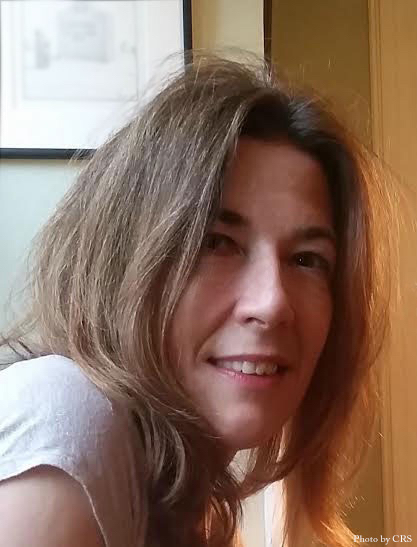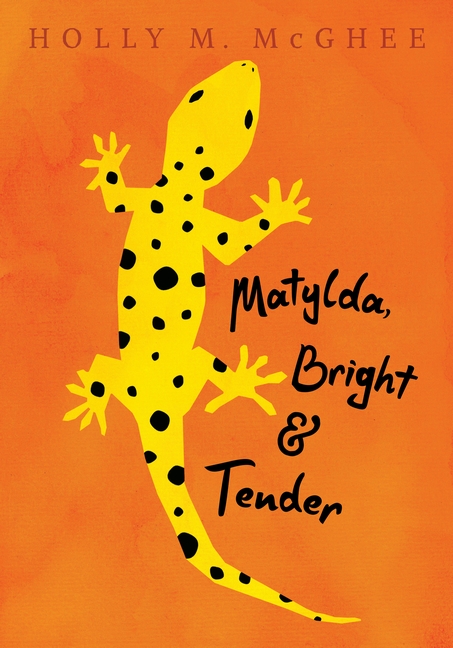 Holly M. McGhee is the author of several books for young people, including the Dessert First trilogy under the pen name Hallie Durand. Matylda, Bright and Tender is her first novel for middle graders. The following is a complete transcript of her interview with Cracking the Cover.
Holly M. McGhee is the author of several books for young people, including the Dessert First trilogy under the pen name Hallie Durand. Matylda, Bright and Tender is her first novel for middle graders. The following is a complete transcript of her interview with Cracking the Cover.
Why do you write? Why specifically for young people?
I grew up in the farmland of upstate New York, where our nearest neighbor was nearly half a mile away . . . and from pretty early on I longed to live in a city . . .I moved to New York as soon as I could, instantly at home with the sound and the lights and the energy and the spirit of the city, and from there I began working as an editor—I vividly remember the day I noticed picture books; I was in my early twenties and came across a copy of Old Mother Hubbard and Her Wonderful Dog by James Marshall. I noticed the hilarious little handwritten notes James Marshall placed throughout the book, details that captured my heart and made me laugh so hard. That was it. I fell in love with children’s books in that moment. And I think after working creatively with so many extraordinary writers and artists as a literary agent, my imagination was ignited and I began writing my own stories, first lighter fare such as my Dessert trilogy and my Mitchell picture books (under pen name Hallie Durand), and now, with Matylda, Bright & Tender and my new picture book Come with Me, the work sprang from a deeper place, one I only gained access to by opening my heart a bit more.
Where did the idea for Matylda, Bright and Tender come from? What inspired you to write it?
I started Matylda in the summer of 2012, but at the 20-page mark, I put it down (for an entire year) once I realized the nine-year-old girl at the center of the book was going to lose her friend. I couldn’t stand it; that’s when I began to understand that the book was about surviving, how things can change in an instant, and I knew it was about my own survival too, having been in a terrible and fatal collision as a teenager. I wanted to reach out to kids who might be suffering, whose parents don’t know what to say to them, I wanted to let them know they’ll be okay somehow, that in time they’ll fold what happened to them into themselves, that they don’t have to fight it, that it will become part of who they are and they’ll be bigger for it. I hope my readers figure this out faster than I did.
Sussy and Guy are the best of friends. How did their relationship change/develop as you were writing?
Guy Hose was actually the name of my own imaginary friend all through nursery school. I used to come home and tell my parents all about Guy Hose and the long grey socks he wore (I guess those were the “hose”) . . . then came the night of the teacher conference when my parents came home and told me the teachers had never heard of my classmate Guy. As my imaginary friend, Guy always represented the darker side of me—he did all the bad things I wished I could do, and I think that’s what is so special about Sussy & Guy—they “see” each other fully, both the dark and light sides, which means they can love each other fully as well. It’s the ultimate friendship.
That fact gave me so much freedom to write their relationship, because I knew in my bones that no matter what happened, in the end Sussy and Guy would still be committed to each other—their relationship rolls from love to anger to hate and back to love again and they became fuller & deeper people in that process. With that core of unconditional acceptance I (as the writer) could do anything with them, just as we can with our real and true friends.
 Why a leopard Gecko?
Why a leopard Gecko?
It was during that year when I put the book down that my son got our first leopard gecko, Speedy. His grandparents gave him $50 for his birthday and that’s all he wanted . . . I didn’t expect to fall so madly in love with this gecko . . . there was a week that summer when I was the only one home, and I was responsible for Speedy . . . and I had to catch the crickets and feed him. I was terrified but I wanted to take good care of him . . . so I did, and I got to know him pretty well . . . when I sat back down to work on Matylda, the gecko showed up to claim a spot.
How does the finished version of Matylda, Bright and Tender compare to its start?
The book grew by 10,000 words for starters. The first chapter became the third. But the biggest emotional shift came from a question Kathi Appelt asked me. In the funeral scene, Sussy promises Guy that she’ll love Matylda enough for them both. Kathi asked me what was at stake for Sussy in that promise. I considered her question for quite some time, until it became clear Sussy thought keeping the promise meant she could hold on to Guy, even in death. It was a powerful question and the answer reverberates throughout the novel. I am forever grateful to Kathi. She is one of the most generous humans I know.
Matylda, Bright and Tender is your first middle grade book. How did writing it differ from previous projects?
While I loved writing the Dessert First trilogy and my picture books, Matylda was a different experience entirely because I was willing to make myself and my readers uncomfortable in order to tell the truth about grief as I know it. But more importantly I had the privilege of holding my readers close as I told Sussy’s story, so that hopefully they come away knowing they can survive whatever life has in store—this is what grief feels like and you can go on, just like Sussy does. The emotional stakes were higher for me with this one.
You were an editor at HarperCollins and now work as a literary agent at your own agency. How did/does your background in the publishing industry influence your writing?
It can be excruciating because I know soooo much: what goes on at acquisitions meetings / marketing meetings / etc. I know that “interest” in a manuscript does not mean “offer”. I know about paper and bindings and headbands and spot varnish—the fine points of production you only learn from being an editor. But I think the biggest influence comes from agenting. Our company philosophy is that “the world owes you nothing / you owe the world your best work.” As a writer, I apply those standards to myself too. I believe that as long as the work is the very best we are capable of at that point in our lives, we can be at peace with the outcome. That doesn’t mean we won’t grow and improve at our writing . . . but we have to put our best effort forth. As agents at Pippin, we always say, “Is that book worth killing a tree for?” And as an author I try to ask myself the same question. It’s sometimes hard to face the answer! But I try to demand the same of myself that I do from the authors and artists with whom I work. It’s hard to be on both sides but it’s also who I am; an agent and a writer—I’m getting more comfortable with my situation with each book I write.
What are you working on now?
I have four projects in various stages of completion . . . one is a picture book I made with my long-time friend, the artist Pascal Lemaitre. The title is Come with Me, and it was born from our mutual experience of the 9/11 terrorist attacks and the lockdown in Brussels last spring. That goes on sale September 5 of this year. Pascal and I are tinkering with another idea now too, and I’ve got a few pages of a middle-grade novel. It’s the first time I’ve had the title of a book before the story . . . maybe that’s a good omen . . .
Is there a book from your own childhood that still resonates with you today?
The first book I ever spent my own money on was an edition of Desiderata by Max Ehrmann. I was in sixth grade and I’m still haunted by some of the lines—in particular:
“Be yourself.
Especially, do not feign affection.
Neither be cynical about love;
for in the face of all aridity and disenchantment
it is as perennial as the grass.”
